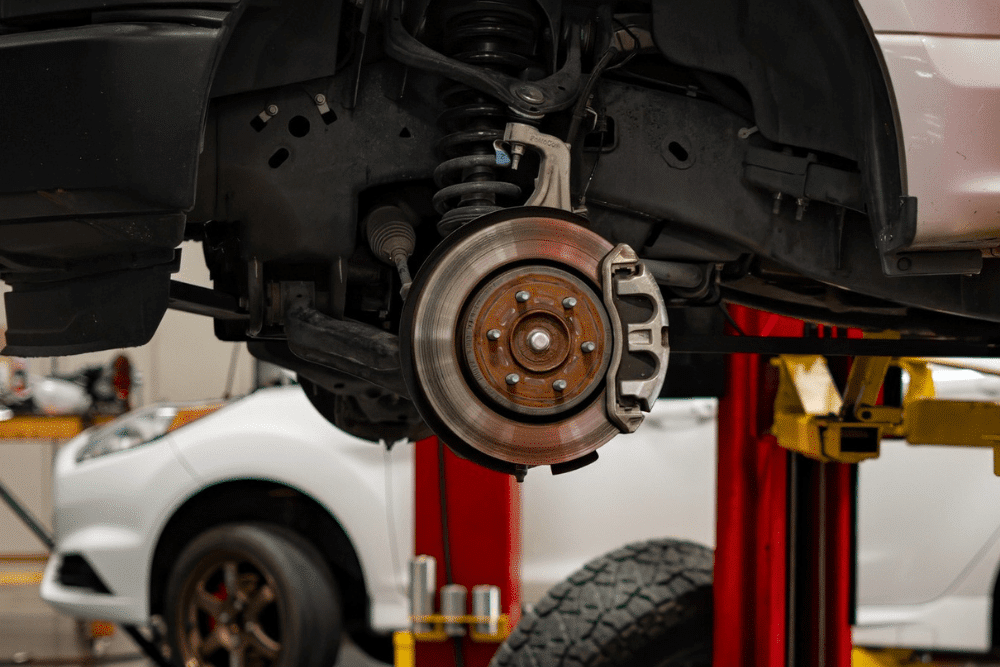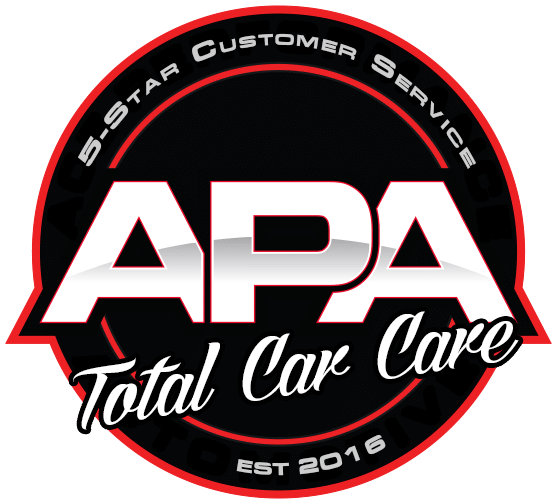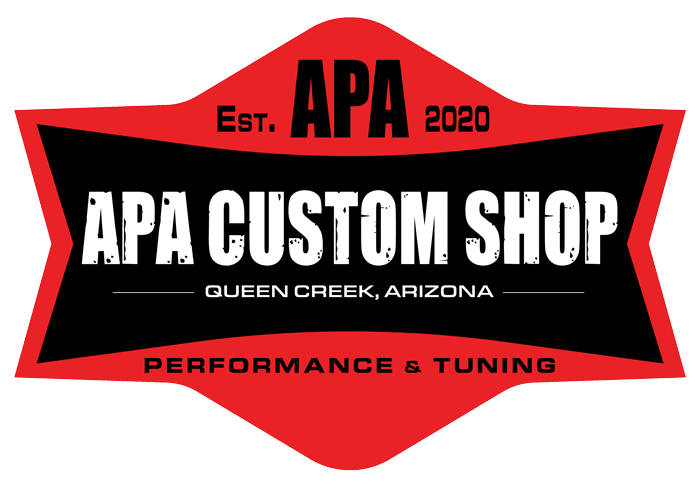What’s Included in a Full Brake Inspection at APA Total Car Care?
Brake inspections might seem simple until you need one that protects your safety.
At APA Total Car Care in Queen Creek, AZ, we believe a brake inspection should do more than just glance at your pads or top off fluid. It should uncover hidden issues, prevent costly repairs, and most importantly, give you confidence behind the wheel. From brake pad wear to caliper performance and fluid condition, we check the parts that other shops often overlook.
Curious about what’s included in a true full-service brake inspection? Here’s what you can expect when you trust your vehicle to APA, and why it matters more than you think.
The Real Value of Brake Inspections

Brakes are one of your car’s most important safety systems. They help you stop quickly and safely in traffic, during emergency maneuvers, or while towing or descending steep hills. But unlike tires or windshield wipers, brake problems aren’t always visible until it’s too late.
Even a slight issue, like worn pads, sticking calipers, or old brake fluid, can reduce braking power and lead to dangerous situations. Regular brake inspections allow you to:
- Catch early signs of wear before they turn into expensive repairs
- Prevent rotor damage caused by worn-out pads
- Ensure your brake fluid is clean and responsive
- Confirm your brake lines and calipers are functioning correctly
- Drive with peace of mind knowing your system is operating as it should
Routine inspections can also extend the life of your brake components and improve your overall driving experience.
What Is Included in a Full Brake Inspection?
Quick Visual Brake Check vs. Full Brake Inspection
What most shops glance at in minutes vs. what APA Total Car Care measures, documents, and verifies for safety.
What a Fast Glance Usually Covers
- ✗Wheels-on look at pads (no precise measurements recorded)
- ✗No rotor thickness, variation, or run-out measurement
- ✗Caliper slide pins/piston movement rarely tested
- ✗No brake fluid moisture/boiling-point test
- ✗Hydraulic system and hose/line leaks not fully inspected
- ✗Parking brake adjustment/operation often skipped
- ✓Very quick (5–10 minutes), but can miss hidden safety issues
- Okay for: a basic pass/fail peek when there are no symptoms.
What APA Total Car Care Includes
- ✓Pads/Shoes: wheels off; gauge-measured inner/outer thickness, glazing/cracks, hardware condition noted
- ✓Rotors/Drums: thickness & variation, run-out, heat spots/scoring; drum integrity (if equipped)
- ✓Calipers/Hardware: piston movement, slide pins, boots, even wear, leaks/fluid seepage
- ✓Fluid/Hydraulics: moisture % & boiling-point test, clarity, master cylinder, lines/hoses, air in system
- ✓Parking Brake: cable adjustment and operation; drum mechanisms, springs, and levers verified
- ✓Road Test & DVI: pedal feel, pull, noise, vibration; photos/video with clear recommendations
- ✓Outcome: prioritized options, transparent estimate, and 3-year/36,000-mile nationwide warranty
A full brake inspection is more than a glance at your brake pads. At APA Total Car Care, our technicians conduct a complete system evaluation using both visual inspection and diagnostic tools. This ensures every part of your braking system is working properly.
Here’s what we look at:
1. Brake Pads and Shoes
Your brake pads are often the first point of wear in your system. We’ll:
- Measure the remaining pad thickness
- Check for glazing, cracking, or uneven wear
- Inspect the backing plate and clips
- Look for contamination from dirt or fluid leaks
Pads wear gradually, but when they reach their minimum thickness, they can damage the rotors and reduce your ability to stop safely.
2. Brake Rotors and Drums When Braking
Your rotors and drums are responsible for creating the friction needed to stop your vehicle. We inspect:
- Rotor surface condition (scoring, warping, heat spots)
- Rotor thickness and variation
- Drum integrity (if applicable)
- Rotor run-out, which can cause pedal pulsation
Even slight imperfections in the rotors can lead to shuddering, vibrations, or longer stopping distances.
3. Brake Calipers and Hardware
The calipers are what press the pads against the rotors. We check:
- Caliper piston movement
- Even pad wear (uneven wear may mean a sticking caliper)
- Leaks or signs of fluid seepage
- Slide pins and mounting hardware condition
Sticking calipers can cause your car to pull to one side during braking and accelerate wear.
4. Brake Fluid and Hydraulic System
Brake fluid is essential for transmitting force from the pedal to the wheels. During your inspection, we:
- Test brake fluid moisture and boiling point
- Examine fluid clarity and consistency
- Check for air in the lines or a low fluid level
- Inspect the master cylinder and lines for leaks
Old or contaminated fluid leads to poor brake response and potential failure, especially in hot climates like Queen Creek.
5. Brake Lines, Hoses, and Parking Brake
Last but not least, we inspect the infrastructure of your braking system:
- Flexible and metal lines for corrosion or wear
- Fittings and hoses for cracking or leaks
- Parking brake cable adjustment and operation
- Spring and lever integrity for drum-style parking brakes
Every part is checked for reliability, giving you a clear picture of your system’s condition.
Brake Checks: Annual Task or Mileage Milestone?
While manufacturer recommendations vary, here’s a general guide for when to schedule a brake inspection:
- Once a year
- Every 12,000–15,000 miles
- Whenever you notice brake noise, vibration, or pedal softness
- Before long trips or if towing frequently
- If your vehicle pulls to one side while braking
In a climate like Queen Creek, with high heat and dusty roads, we often recommend more frequent checks. If you’re unsure when your last inspection was, book a brake inspection to avoid surprises.
The Top Brake Problems That Go Undetected Until It’s Too Late
Many drivers are surprised by what’s uncovered during a routine inspection. The most common problems include:
- Worn pads near or below the minimum thickness
- Warped or scored rotors from heat or metal-on-metal contact
- Stuck calipers causing uneven braking or pulling
- Brake fluid contamination, usually from age or moisture
- Air in brake lines, reducing hydraulic pressure
- Leaking master cylinder or brake hoses
- Faulty parking brake components
Catching these issues early can save you from more expensive repairs like rotor or caliper replacement. It also helps maintain optimal braking performance for your safety.
How Arizona Heat Affects Your Brakes
One of the most unique challenges Queen Creek drivers face is the heat. Brake systems generate a lot of friction, which creates heat, but in Arizona, they’re already starting at high temperatures.
Here’s how heat can impact your brakes:
- Brake fluid boils more easily, leading to a soft pedal and reduced stopping power
- Rotors warp faster when exposed to high temperatures repeatedly
- Dust and debris from dry roads can infiltrate brake components
- Friction material wears faster, especially during summer towing or mountain drives
For this reason, we always test your brake fluid during inspections and check for signs of heat damage in rotors and pads. If your driving includes a lot of hills, hauling, or high-speed braking, you may need inspections more often.
Tips to Extend the Life of Your Brakes
While wear is inevitable, smart habits can extend the lifespan of your braking components:
- Coast before braking when approaching stops
- Avoid riding the brake pedal, especially downhill
- Give yourself more stopping distance in traffic
- Downshift when towing or descending long grades
- Flush brake fluid every 2 years or as needed
- Rotate your tires regularly, which helps distribute braking force evenly
A little preventative care can go a long way in reducing your overall brake repair costs and helping your vehicle perform better over time.
Trusted in Queen Creek: Our Approach to Brake Safety and Service
At APA Total Car Care, we take pride in delivering more than just routine service. Our brake inspections are:
- Thorough: Every inspection is done by ASE-certified techs trained to identify subtle signs of wear and damage.
- Transparent: We use digital vehicle inspections through Tekmetric, so you can see photos and videos of your brake components before approving any repairs.
- High-tech: We use high-end tools like the Hunter Hawkeye alignment system to detect suspension or alignment issues that contribute to uneven brake wear, and the Autel MaxiSys Ultra scanner to diagnose electronic brake system problems like ABS faults, helping us catch issues early and ensure a more complete, accurate brake inspection.
- Backed by warranty: Our brake repairs come with a 3-year/36,000-mile nationwide warranty, valid in Canada and Mexico.
- Customer-focused: We treat every vehicle like it’s our own and ensure you understand your brake condition without pressure.
Our commitment to integrity and excellence has earned us recognition as a CarFax Top-Rated Service Shop for five years in a row, a distinction we’re proud to share with the Queen Creek and San Tan Valley communities.
Want to learn more about our complete brake services? Visit our Brake Repair and Services page for details on inspections, repairs, and everything in between.
We’ve Checked Your Brakes. Here’s What You Can Expect Next
After completing your brake inspection, you’ll receive a full digital report outlining:
- The condition of your pads, rotors, and calipers
- Any fluid or hydraulic issues found
- Recommendations for service or replacement
- Photos and videos to back our findings
- Transparent pricing with no pressure to commit
You’ll leave with all the information you need to make a confident decision about your vehicle’s care.
Frequently Asked Questions (FAQ)
Are there different types of brake inspections?
Yes. Some shops offer quick visual checks during an oil change, but a complete brake inspection includes an in-depth evaluation of calipers, fluid, hardware, and hydraulics. Always ask what’s included to ensure you’re getting a full assessment.
Do all vehicles use the same brake system?
No. Most modern cars use disc brakes, but some still have drum brakes in the rear. Trucks, performance, and older vehicles often have unique brake configurations. This is why it’s important to have inspections done by certified technicians.
Can I drive with minor brake noise if my car still stops fine?
Even small noises can mean pad wear, caliper sticking, or rotor issues. It may not feel urgent, but waiting too long can lead to more costly damage. It’s smart to have it inspected as soon as possible.
Does my driving style affect brake inspection frequency?
Yes. Frequent towing, city driving, heavy traffic, or downhill braking will wear your brakes faster. If this sounds like your routine, aim for twice-yearly inspections instead of just once a year.
Hear a Squeak? Feel a Pull? Let’s Take a Look
Brake issues rarely go away on their own. They usually get worse the longer you wait. If you’re unsure about the last time your brakes were checked, or if you’ve noticed squeaks, pulling, or reduced stopping power, now is the right time to act. APA Total Car Care is here to make brake inspections simple, clear, and trustworthy.
Visit us at 22325 S. Scotland Court, Suite 101, Queen Creek, AZ 85142, give us a call at 480-539-6872, or book your appointment online. We’ll give you real answers and real solutions, because your safety is worth it.

